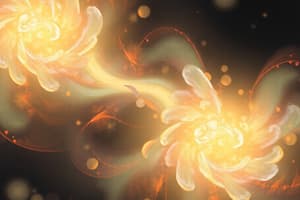Podcast
Questions and Answers
Which state of matter has particles that are hard to compress and packed tightly together?
Which state of matter has particles that are hard to compress and packed tightly together?
- Solids (correct)
- Gases
- Liquids
- Plasmas
In which state of matter do the particles spread out to fill their container?
In which state of matter do the particles spread out to fill their container?
- Liquids
- Plasmas
- Solids
- Gases (correct)
Which state of matter takes the shape of its container and can flow from place to place?
Which state of matter takes the shape of its container and can flow from place to place?
- Liquids (correct)
- Plasmas
- Solids
- Gases
Which process involves changing from a liquid to a gas?
Which process involves changing from a liquid to a gas?
Which factor influences the amount of energy needed to change the state of a substance?
Which factor influences the amount of energy needed to change the state of a substance?
Study Notes
- Three common states of matter are solids, liquids, and gases, with particles arranged differently in each state.
- Solids are hard to compress, have a fixed shape, and particles are packed together with almost no spaces between them.
- Liquids are also hard to compress, take the shape of their container, and flow from place to place due to particles being close together but able to move.
- Gases are easy to compress, spread out to fill their container, and have widely spaced particles that move quickly and randomly.
- Changing the state of a substance involves putting in or taking out energy, like melting (solid to liquid), boiling (liquid to gas), and condensing (gas to liquid), with the amount of energy needed influenced by the strength of forces of attraction between particles.
Studying That Suits You
Use AI to generate personalized quizzes and flashcards to suit your learning preferences.
Description
Test your knowledge about the three common states of matter - solids, liquids, and gases, along with the processes of changing between these states such as melting, boiling, and condensing. Learn about the unique characteristics and behaviors of particles in each state.




